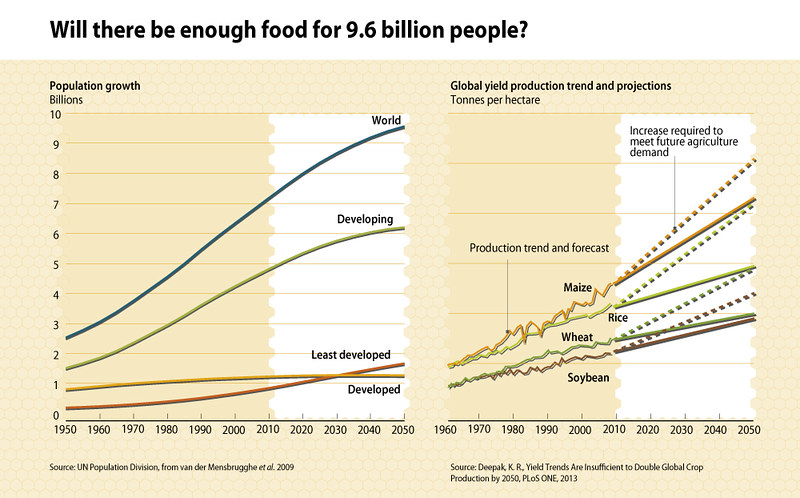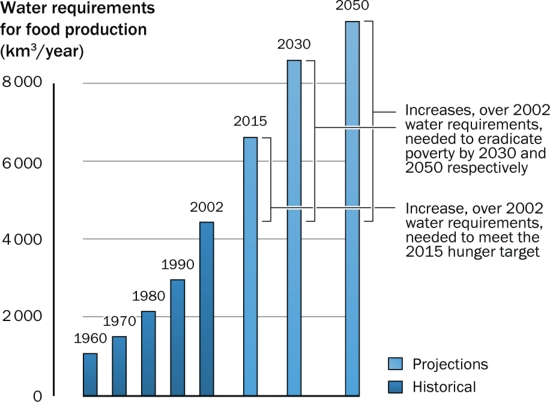Finding the right balance between using fertilizers for intensification of food production and reducing the impact of fertilizers on the environment
Pejman Djavdan (professional)
SUSTAINABLE DEVELOPMENT GOAL 2: Beëindig honger, bereik voedselzekerheid en verbeterde voeding en promoot duurzame landbouw https://www.unric.org/nl/sdg-2
Ending hunger without compromising our planet
One of the most pressing problems of humanity in this century is how a growing global population can feed itself in an appropriate way and live in harmony with the planet and its finite resources.
The second United Nations Sustainable Development Goal is to “End Hunger, Achieve Food Security and Improved Nutrition and Promote Sustainable Agriculture”.
The world population has increased rapidly in the last decades from around 2 billion in 1927 to 3 billion in 1960 to 7 billion in 2011 and is expected to grow to around 10 billion by 2055. While the population is growing exponentially, the amount of food used per capita is also growing. The FAO has estimated that the global crop production needs to increase by over 45% by 2050 if we want to end hunger and malnutrition.
It is clear that we need to intensify crop and food production if we want to be able to feed the world population and achieve food security. The question is not whether we need to intensify but how we intensify food production in a sustainable manner. How do we make sure that we grow sufficient crops and produce sufficient food that has better quality, is economically available for everyone and has less impact on the environment and our planet (Fig 1)? This article will try to address this challenge.

Figure 1 The challenge we are facing – source GRID – Arenal, Flickr.
Intensification is a must
Although the amount of arable land has remained constant across the globe as of 1960 (ca. 1.2 billion ha), the average crops yields per hectare have continued to rise steadily and in line with the relentless increase in population. The role played by improved fertilizers in helping to feed the world, cannot be overstated. As an example, the average cereal yield per ha in Europe has tripled as of 1960 from 1.5 tons/ha to more than 4.5 tons/ha. This is due to the use of fertilizers in Europe (currently ca. 200 kg per ha per year).
Today more than 50% of food production is based on mineral fertilizer inputs. It seems inevitable that with the projected crop production increase, also the amount of mineral fertilizer inputs will increase. The additional amount of agricultural land available for food production is limited, this means that almost all crop production growth needs to come from increasing mineral fertilizer inputs and improved agricultural practices.

Water Requirements for food production, photo credits: GRID-Arendal, Flickr
While greenhouse gas emissions from fertilizer production and application have increased over the years, the net effect of higher crop yields has avoided emissions up to 590 Gt-CO2 between 1961 and 2005 as shown in a study by Burney et al in 20101. This means that intensification not only has a positive impact on food production, but also has a net positive impact on avoiding emissions, as 3 times less land is needed to produce the same amount of food.
However this does not mean that we should ignore the impact of Nutrient Use Efficiency (NUE), which is the ratio between nutrient input in the form of both organic and mineral fertilizers, and nutrient output in the form of harvested crops on the environment. At the current Nutrient Use Efficiency (NUE) a growing amount of nutrients are lost to the environment. The amount of nutrients lost is increasingly creating serious problems in certain areas of the world (Fig.2). Examples are the increasing nitrate levels in ground water for drinking water in Europe, dead zones in the Gulf of Mexico and the Chesapeake Bay, heavy algae growth in nearly all surface waters in China, etc. Even though using mineral fertilizers and intensification are necessary for food production and also does not require the expansion of arable land, it is still important to intensify wisely with fertilizers that have minimal impact on the environment.
Different approaches in different areas
The target the global fertilizer industry is facing is twofold. On the one hand increasing the mineral fertilizer application notably in Sub Saharan Africa, where currently, as a result of increasing crop need and an almost absence of fertilizer application, agricultural soils are mined and nutrient levels in these soils are decreasing. This will ultimately lead to further deterioration of crop yields and potentially desertification. On the other hand, mineral fertilizer application should decrease notably in East Asia, where as a result of adverse subsidy schemes, the use of nitrogen fertilizer is very high, without the usual response in yield. In China as a result of very high fertilizer inputs some soils are already degraded and cannot be used for crop production anymore.
Therefore, we need to change our agricultural practices. While in some areas like Africa, we need to increase intensification, in other areas, like China, we need to increase NUE by using smarter fertilizers and smarter practices.
Smart use of fertilizers and smart fertilizers
The fertilizer industry can help to address this problem at several levels. Many initiatives are taken to optimize the fertilization in relation to the real fertilizer demand, such as supporting soil sampling techniques. Other examples are: providing fertilization advise tools which can suggest when to apply which fertilizer, cropping schemes giving direct advice what fertilizer to use, more balanced application of different nutrients, etc. There are many such initiatives like the 4R Nutrient Stewardship (Right Source, Right Rate, Right Time and Right Place) in the USA, or the ‘Smart use of fertilizers’ in Europe.
Another route is to develop ‘Smart fertilizers’ which provide the nutrients needed for the crop to grow in a constant and steady way. This prevents oversupply right after the application of the fertilizer, which is lost to the environment and is causing environmental concerns. These ‘smart fertilizers’ are based on fertilizers coated with polymer membranes which provide a slow and controlled release of the nutrients captured inside the membrane (Fig.3). Field trials have shown that the NUE of such products are significantly higher, supporting the trend towards lower losses.
Stamicarbon is working together with Pursell Agri-Tech (PAT) to make controlled release fertilizers more accessible for commodity crops. Currently, we are building the first commercial plant in Alabama, USA and will start licensing this new technology as soon as the first plant is operational in June this year.
Adding micro nutrients to the land to improve the quality of food
One other major problem in agriculture is that the quality of our land is degrading. We have been adding macro nutrients (N, P, K and S) to the land to intensify agriculture which we deem necessary. However, we are learning more and more that the crops also need micro nutrients like Zinc, Iodine, copper, iron, etc. for the plant not only to grow healthier, but also to become better and healthier food for us.
Adding these micro-nutrients to the land in a balanced way is becoming the next challenge of innovation in the fertilizer industry.
There is a lot of research done in adding micro nutrients and bio-stimulants to the mineral fertilizers. These types of research studies show that adding micro nutrients and bio-stimulants to the fertilizers not only improve the health and growth of the plants but also the quality of the fruits, grains and vegetables and the quality of the food that is produced using these fortified plants. It creates a sort of super food: grains that have 10 times more Iodine for example than normal grain and are bigger and heavier, so that the amount of bread that a normal person eats a day leads to sufficient Iodine intake per day and vegetables that have much more Zinc and Magnesium.
This would mean that we do not need to fortify processed food anymore or take extra vitamin tablets to get sufficient minerals and anti-oxidants. Our non-processed fruits, vegetables and our bread and rice will contain sufficient minerals and anti-oxidants.
Prediction tools
Academia have provided numerical tools which show that the growing crop demand can be achieved by a similar nutrient application through fertilizers in 2050 as compared with 2010, under the premise that the nutrient use efficiency will increase from a level of 42% in 2010 towards 68% in 2050. All of the above tools which are currently available like the ‘Smart use of fertilizers’ and the ‘Use of smart fertilizers’ can support this trend towards growing crop production. At the same time the increase of the NUE, will decrease the loss of nutrients from 58% in 2010 to 32% in 2050, which is an almost 50% decrease of losses to the environment. This will thus support the decrease of the environmental pressure.
Innovations in fertilizer industry
There is awareness both in the fertilizer industry and in general about the increasing needs of agricultural productivity and its possible impact on the environment. These two may seem contradictory when viewed from a polarizing angle, however both are important and need to be addressed simultaneously.
Humanity would be best and most effectively served by setting aside partisan disputation and pursuing united action that is informed by the best available scientific evidence to support the United Nations Sustainable Development Goal #2, by increasing the crop production to End Hunger, Achieve Food Security and Improved Nutrition and Promote Sustainable Agriculture.
To do so, we need to continue to innovate, collaborate and challenge the status quo. To Pioneer with a higher purpose to enable the world to feed itself and improve the quality of life.
Master’s degree in Engineering from Delft University of Technology
Chief Executive Officer of Stamicarbon and Technology BV (Maire Tecnimont Group)
Notes
- Greenhouse gas mitigation by agricultural intensification, Jennifer A. Burney, Steven J. Davis and David B. Lobell
- Managing nitrogen for sustainable development, Xin Zhang, Eric A. Davidson, Denise L. Mauzerall, Timothy D. Searchinger, Patrice Dumas & Ye Shen
